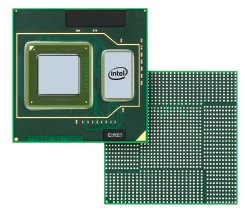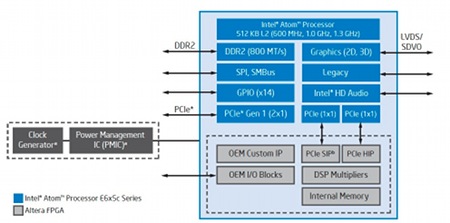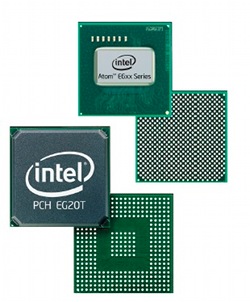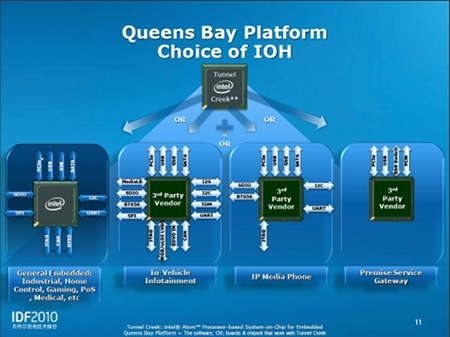New Atoms are configurable via onboard FPGAs
Nov 22, 2010 — by LinuxDevices Staff — from the LinuxDevices Archive — 5 viewsIntel announced six Atom processors that include on-chip Altera FPGAs (field programmable gate arrays). Offered in versions up to 1.3GHz, the Atom E6x5C processors will make it easier for customers to create custom-made designs, save on board space, and are offered with seven-year manufacturing support, the company says.
 Intel's Atom E6x5C processors, previously code-named "Stellarton," were first promised back in September, when the chipmaker announced the other models in its Atom E6xx line (see later in this story for background). On a single 37.5 x 37.5mm package (right), the new offerings combine an Atom CPU and an Altera FPGA, linked by a dedicated PCI Express lane, the company says.
Intel's Atom E6x5C processors, previously code-named "Stellarton," were first promised back in September, when the chipmaker announced the other models in its Atom E6xx line (see later in this story for background). On a single 37.5 x 37.5mm package (right), the new offerings combine an Atom CPU and an Altera FPGA, linked by a dedicated PCI Express lane, the company says.
According to Intel, the combo saves on board space and provides increased design flexibility, making the E6x5C "ideal for market segments such as industrial machines, portable medical equipment, communications gear, vision systems, voice over Internet protocol devices, high-performance programmable logic controllers, and embedded computers." The 45nm chips will be available for at least seven years, promises the company.
Basic CPU features, which include a 2D/3D graphics engine with a core frequency of up to 400MHz, carry over from the earlier E6xx Atoms. But the added, user-programmable FPGA has more than sixty thousand logic elements, providing enough programmable space for users to integrate their own intellectual property, or use off-the-shelf, third-party IP, Intel says.

A block diagram of Intel's E6x5C
(Click to enlarge)
According to Intel, other features of the onboard FPGAs include:
- transceiver speeds up to 3.125 Gbps
- high-speed LVDS with SERDES at up to 840Mbps
- support for DDR3, DDR2, DDR, QDR II and QDR II+ memory
- up to four general-purpose PLLs
- 312 18 x 18 multipliers
- 350 user I/O pins
The table below shows Intel's overall Atom E6xx line, with the new FPGA-equipped devices (the "C" stands for "configurable") highlighted in red. As can be seen, TDPs for the E6x5C devices differ little from their standard counterparts.
| Clock speed (GHz) | Graphics speed (MHz) | TDP (Watts) | Temperature range (deg. C) | |
| Atom E620 | .6 | 320 | 2.7 | 0 to 70 |
| Atom E620T | .6 | 320 | 2.7 | -40 to 85 |
| Atom E625C | .6 | 320 | 2.7 | 0 to 70 |
| Atom E625CT | .6 | 320 | 2.7 | -40 to 85 |
| Atom E640 | 1.0 | 320 | 3.3 | 0 to 70 |
| Atom E640T | 1.0 | 320 | 3.3 | -40 to 85 |
| Atom E645C | 1.0 | 320 | 3.6 | 0 to 70 |
| Atom E645CT | 1.0 | 320 | 3.6 | -40 to 85 |
| Atom E660 | 1.3 | 400 | 3.3 | 0 to 70 |
| Atom E660T | 1.3 | 400 | 3.3 | -40 to 85 |
| Atom E665C | 1.3 | 400 | 3.6 | 0 to 70 |
| Atom E665CT | 1.3 | 400 | 3.6 | -40 to 85 |
| Atom E680 | 1.6 | 400 | 3.9 | 0 to 70 |
| Atom E680T | 1.6 | 400 | 3.9 | -40 to 85 |
The Atom E6xx family, with FPGA-equipped offerings highlighted in red
Intel notes, however, that total TDP will ultimately depend on what functions a customer chooses to include in a design. Tools included with Altera's Quartus II design software may be used to perform power calculations, the chipmaker adds.
Separately, Altera has said Quartus II will let developers "apply a single design flow to a diversity of processors." Last month, the company announced that it had licensed ARM's Cortex-A9 core and will incorporate it into a 28nm chip integrating FPGA technology during 2011. A soft processor core based on MIPS Technologies' MIPS32 architecture will be released earlier in the year, Altera added at the time.
Doug Davis, Intel's vice president and general manager for its Embedded and Communications Group, stated, "Our customers' needs are continually evolving and they look to Intel to provide leading-edge products and technologies that will help them differentiate and compete in the markets they serve. Our new configurable Atom series helps to address these customer needs and provides greater flexibility with a simplified product choice, through one vendor."
Atom E6xx background
 Intel announced the E6xx Atoms (right), previously known by their "Tunnel Creek" codename, at its Intel Developer Forum (IDF) in September. The E6xxs are among the many successors to Intel's original Atom, the Z5xx, whose "Silverthorne" CPU was paired with a "Poulsbo" northbridge/southbridge in an overall platform nicknamed "Menlow."
Intel announced the E6xx Atoms (right), previously known by their "Tunnel Creek" codename, at its Intel Developer Forum (IDF) in September. The E6xxs are among the many successors to Intel's original Atom, the Z5xx, whose "Silverthorne" CPU was paired with a "Poulsbo" northbridge/southbridge in an overall platform nicknamed "Menlow."
Like Menlow, the E6xx is aimed at embedded devices and in-car platforms (though we should note that the Z5xx continues to find a home in some mobile internet devices (MIDs), tablets, and netbooks, too). And, like Intel's later "Menlow XL" Z530P and Z530PT, the E6xx measures 22 x 22mm and is still produced using 45nm technology.
But Intel now refers to the Atom E6xx as a SoC (system on chip), justifying this by incorporating a graphics controller (known as the GMA600, and reportedly based on Imagination Technologies' PowerVR SGX IP), memory controller, and audio onto the Atom itself. Like the company's "Pineview" Atoms, the N450, D410, and D510, Tunnel Creek employs a relatively simple IOH I/O controller: In this case, it's the PCH (platform controller hub) EG20T, measuring 23 x 23mm (block diagram, here).
According to Intel, the E6xx and EG20T platform (previously known as "Queens Bay") has an overall package size that's 46 percent smaller than Menlow. It's said the platform also offers OEMs much greater versatility than did Menlow or even Pine Trail (the chipmaker's name for the Pineview Atoms and their NM10 or ICH8 I/O controller). That's because instead of using a proprietary interconnect, Tunnel Creek communicates with the IOH via an industry-standard PCI Express bus.

The E6xx's PCI Express bus enables third-party I/O controllers
Source: Intel (Click to enlarge)
Intel anticipates third-party vendors will create their own IOH chips for the E6xx that add custom functionality for applications such as in-vehicle infotainment, IP media phones, and premise service gateways. Meanwhile, the chipmaker says, the EG20T will be offered for those requiring typical interfaces such as SATA, USB client, SD/SDIO/MMC, and gigabit Ethernet, as well as general embedded interfaces such as CAN, IEEE 1588, SPI, I2C, UART, and GPIO.
As the E6xx's power consumption and size make clear, the platform is not as revolutionary as Intel's long-promised "Moorestown" platform, which finally made its debut in May as the Atom Z6xx. Incorporating similar GMA600 on-chip graphics, the Z6xx measures just 13.8 x 13.8mm and features ultra-low power states that will enable devices to stand by for as long as ten days. The Z6xx is connected to its MP20 I/O controller via Intel's proprietary DMI, not PCI Express.
Further information
With its Intel-provided drivers, the E6x5C devices will support Windows XP, Windows Embedded Standard 2009, and Windows 7. Support for the Linux-based MeeGo 1.0 and VXWorks will be provided by the MeeGo community and Wind River, the chipmaker adds.
According to Intel, the E665CT, E645CT, E665C, and E645C are scheduled to be available within 60 days, while the E625CT and E625C are on track to be available in the first quarter of 2011. Prices will range from $61 to $106 in quantities of 1,000, according to the chipmaker.
Intel added that Kontron is now sampling E6x5C prototype boards, and plans to enter full production with its devices in the second quarter of 2011. We'll provide further information on these products when Kontron makes it available.
More information on the E6x5C devices may be found on Intel's website, here [PDF link].